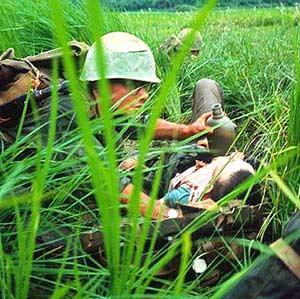 AP photographer Julie Jacobson was reticent to publish her picture of dying US Marine Lance Cpl. Joshua Bernard. Though his father was opposed, the Associated Press overruled. But this was no victory for the public’s right to see a true reflection of war. The D.o.D. is still indignant, but I suspect Jacobson’s report was ultimately vetted in their favor. Military propagandists need to represent America’s growing losses in Afghanistan. Jacobson’s image provides their limited hangout. Like the other photographs of casualties which have escaped through embeds, the image of Lance Corporal Bernard is desaturated of blood, and the surrounding events fit the military endorsed narrative.
AP photographer Julie Jacobson was reticent to publish her picture of dying US Marine Lance Cpl. Joshua Bernard. Though his father was opposed, the Associated Press overruled. But this was no victory for the public’s right to see a true reflection of war. The D.o.D. is still indignant, but I suspect Jacobson’s report was ultimately vetted in their favor. Military propagandists need to represent America’s growing losses in Afghanistan. Jacobson’s image provides their limited hangout. Like the other photographs of casualties which have escaped through embeds, the image of Lance Corporal Bernard is desaturated of blood, and the surrounding events fit the military endorsed narrative.
Have you noticed that all combat images coming out of today’s wars are drab and lifeless. Obviously this motif is not being applied to the PR shots of jets and military hardware, but scenes of soldiering in Iraq and Afghanistan are dusty and grey, like scenes from a dark virtual world.
The colors in Jacobson’s controversial photo are similarly under saturated. Earlier casualty pics have even been rendered as black and white, and this is no exercise of artistic license. Colorless images telegraph little resemblance to our real world lived in color. An emotional distance is created, most obviously like the detachment we feel looking into the past. Everything before the late sixties happened in monocrome. Early color photographs always shock children with the prospect that lives in generations past might have been been lived in a world of contemporary vibrance.
The photographs from Vietnam were helped by that nation’s lush tropical greens. Images of the wounded were all the more gripping –and demoralizing from the military’s point of view– because unlike in Korea and WWII, the blood was red.
Most images taken in Vietnam came through the military staff photographers. The unapproved subjects, which subverted the official face of the war, emerged from the cameras of independent journalists.
 Julie Jacobson facilitated the release of this picture, by letting slip two details pertinent to the official US narrative in Afghanistan. Would you believe, just prior to this engagement, friendly Afghans came out of their houses to tell the US soldiers where they could find the Taliban? Probably to ensure Corporal Bernard’s squad pointed their guns away from their homes, but that’s not how the story was spun. Jacobson recounts that these Afghans were eager to inform on the Taliban.
Julie Jacobson facilitated the release of this picture, by letting slip two details pertinent to the official US narrative in Afghanistan. Would you believe, just prior to this engagement, friendly Afghans came out of their houses to tell the US soldiers where they could find the Taliban? Probably to ensure Corporal Bernard’s squad pointed their guns away from their homes, but that’s not how the story was spun. Jacobson recounts that these Afghans were eager to inform on the Taliban.
The jocular Jacobson records another telltale crowd-pleaser in the aftermath of the Taliban “ambush,” when she found herself flanked by Afghan National Army troops. When the firing started, Jacobson sought immediately the ranks of US soldiers, because the freakin’ ANA Afghans “aren’t very good.”
Today’s media embeds are basically a privatized signal corps. Their photos should belong to the taxpayers. Insinuations that military families should dictate what images can be used, in the event of death, is a cruel irony. Are the families consulted about what Uncle Sam wants to do with their loved one when he’s still alive? Millions of federal tax dollars are spent on our soldiers, all the more when they die. I have little sympathy for the families who couldn’t stand up for their children and protect them from the capricious whims of our military. There is absolutely no reason to ask their permission about what happens when their little soldier meets his/her calculable fate.
